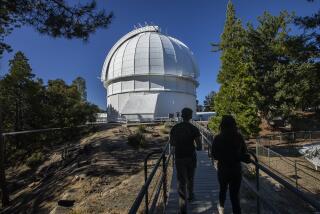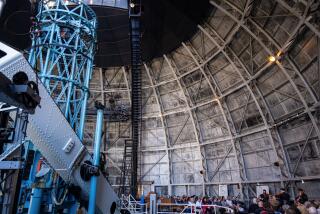Mt. Laguna Observatory Makes Big Leagues on Tiny Silicon Chip
- Share via
SAN DIEGO — A tiny wafer of silicon is pulling the Mt. Laguna Observatory east of San Diego from the backwaters of astronomy into a revolutionary new approach to unlocking the heaven’s secrets.
Called a charge-coupled device, or CCD, the electronic wonder is a sophisticated version of the imaging chip used in those low-light home video cameras.
But, for San Diego State University astronomers, working with the CCD has been like getting Mt. Palomar’s 200-inch telescope magically transported 45 miles southward to the Laguna Mountains.
Since being installed on Aug. 15, the CCD already has enabled astronomers to do work at Mt. Laguna that was unheard of before the device arrived, said Ron Angione, SDSU’s astronomy chairman and director of the observatory.
“It allows us to reach objects with our one-meter telescope that in the past it would have taken a 200-inch telescope to see,” Angione said. “We can go 100 times fainter than we did before.”
About 35 miles east of San Diego, near Pine Valley, Mt. Laguna has functioned as a respectable but relatively obscure observatory for two decades as a research tool for astronomers from SDSU and the University of Illinois at Urbana-Champaign. The two institutions operate it jointly.
Laguna’s telescopes, with mirrors 39, 24 and 16 inches across, are professional quality, but they are not big enough to be world-class telescopes making discoveries in the deepest reaches of space.
But the 75 CCDs being distributed to Mt. Laguna and other observatories under a joint NASA/National Science Foundation program will greatly expand the “seeing” ability of U.S. astronomers at smaller observatories, said Jim Westphal, an astronomy professor at Caltech.
They will be able to do work that, a decade ago, could be done only by the biggest instruments, he said.
“We’re increasing almost by a factor of two the number of groups and people who can do this kind of work,” Westphal said. “It’s a mighty cheap way to get the advantages of a big telescope.”
While a CCD and its associated computer hardware can cost about $350,000, a major new telescope like the Keck Observatory being built in Hawaii runs more than $80 million.
Recognizing that cost factor, NASA and the Science Foundation are giving the 75 CCDs left over from NASA’s planned Hubble Space Telescope to 27 groups around the country. About half the recipients are larger observatories, but the remainder are smaller ones like Mt. Laguna, Westphal said.
The Mt. Laguna CCD, manufactured by Texas Instruments, is a square of iridescent silicon, slightly smaller than a quarter and with a thickness about a tenth the diameter of a human hair. Etched on its surface are microscopic square indentations--”pixels”--that record light better than any photographic system, scientists agree.
The pixels form an 800-by-800 checkerboard array of electronic buckets, for catching light that is gathered by the telescope’s mirror and then funneled to the CCD.
Faint Stars Wash Out
In a photograph, the traditional tool used in optical astronomy, a bright star next to a very faint star washes out the image of the fainter star, because photographs can show only 64 gradations between black and white.
But the CCD can sort out 5,000 different light intensities. So, with the help of a computer to screen out the electrons generated by the brighter star, the faint star’s signal can still be sorted out.
Until recently, the few astronomical-quality CCDs being made were in use only in large, well-funded telescopes.
“The entire rest of the astronomical community has been hunting for good scientific-quality CCDs, and have not been able to find any,” Tyson said. “And that’s why this National Science Foundation distribution of space telescope spinoff CCDs will have made a fairly big improvement in the situation.”
At Mt. Laguna, the CCD means whole new worlds of astronomy for the nine faculty members at SDSU and Illinois who split 90% of the available observing time. The other 10% is allocated to visiting researchers, who already are making inquiries about using the newly improved telescope system, Angione said.
Demand is likely to increase further next year when Kitt Peak National Observatory near Tucson closes down its 36-inch telescope, which has been dedicated to the kind of work that Mt. Laguna will be able to do best, Angione said.






